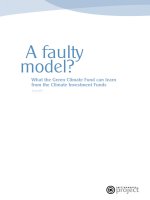Grossman wrong; nine economic policy disasters and what we can learn from them (2013)
Bạn đang xem bản rút gọn của tài liệu. Xem và tải ngay bản đầy đủ của tài liệu tại đây (1.14 MB, 291 trang )
WRONG
This page intentionally left blank
WRONG
Nine Economic Policy Disasters
and What We Can Learn
from Them
Richard S. Grossman
1
1
Oxford University Press is a department of the University of Oxford.
It furthers the University’s objective of excellence in research, scholarship,
and education by publishing worldwide.
Oxford New York
Auckland Cape Town Dar es Salaam Hong Kong Karachi
Kuala Lumpur Madrid Melbourne Mexico City Nairobi
New Delhi Shanghai Taipei Toronto
With offices in
Argentina Austria Brazil Chile Czech Republic France Greece
Guatemala Hungary Italy Japan Poland Portugal Singapore
South Korea Switzerland Thailand Turkey Ukraine Vietnam
Oxford is a registered trademark of Oxford University Press
in the UK and certain other countries.
Published in the United States of America by
Oxford University Press
198 Madison Avenue, New York, NY 10016
© Richard S. Grossman 2013
All rights reserved. No part of this publication may be reproduced, stored in a
retrieval system, or transmitted, in any form or by any means, without the prior
permission in writing of Oxford University Press, or as expressly permitted by law,
by license, or under terms agreed with the appropriate reproduction rights organization.
Inquiries concerning reproduction outside the scope of the above should be sent to the Rights
Department, Oxford University Press, at the address above.
You must not circulate this work in any other form
and you must impose this same condition on any acquirer.
Library of Congress Cataloging-in-Publication Data
Grossman, Richard S.
Wrong : nine economic policy disasters and what we can learn from them /
Richard S. Grossman.
p. cm.
Includes bibliographical references and index.
ISBN 978–0–19–932219–0 (alk. paper)
1. Financial crises—Case studies. 2. Economic policy—Case studies. I. Title.
HB3722.G76 2013
339.509'04—dc23
1 3 5 7 9 8 6 4 2
Printed in the United States of America
on acid-free paper
For Ruth, with love
Du, meine Freundin, mein Zuhaus,
Mein Weg zurück, mein Blick voraus,
Mein Jetzt, mein Damals, mein Inzwischen.
Mein Aufbruch, meine Wiederkehr,
Du, mein Wohin und mein Woher...
Reinhard Mey
This page intentionally left blank
The problem with any ideology is it gives the answer before you look at
the evidence. So you have to mold the evidence to get the answer that
you’ve already decided that you’ve got to have. It doesn’t work that way.
BILL CLINTON, September 20, 2012
This page intentionally left blank
CONTENTS
Preface | xi
Prologue | xiii
1. Introduction | 1
2. How to Lose an Empire without Really Trying: British
Imperial Policy in North America | 18
3. Establish, Disestablish, Repeat: The First and Second
Banks of the United States | 34
4. The Great Hunger: Famine in Ireland, 1845–1852 | 54
5. The Krauts Will Pay: German Reparations after
World War I | 68
6. Shackled with Golden Fetters: Britain’s Return to the Gold
Standard, 1925–1931 | 82
7. Trading Down: The Smoot-Hawley Tariff, 1930 | 101
8. Why Didn’t Anyone Pull the Andon Cord? Japan’s
Lost Decade | 121
ix
x
Contents
9. The Worst Financial Crisis since the Great Depression:
The Subprime Meltdown | 137
10. I’m OK. Euro Not OK? | 152
11. What Have We Learned? Where Do We Go from Here? | 174
Notes | 187
Bibliography | 213
Index | 241
PREFACE
This book is about failure. Specifically, it is about economic policy
mistakes which, combined with bad luck, led to some pretty awful
outcomes: a lost decade that humbled an economic superpower; an
economic depression that was the worst the industrialized world has
ever seen; and a devastating famine that led to emigration, misery,
and death. Not exactly a tour through history’s lighter moments.
Given the depressing subject matter, a reader might conclude
that the author is obsessed with bad choices and bad luck—in short,
failure. Nothing could be further from the truth. While writing
this book, colleagues, friends, and family have served as a constant
reminder of the very good fortune that I enjoy every day. I am grateful to Jorge Arroyo, Teo Dagi, Barry Eichengreen, Jeff Frieden, Ruth
Grossman, Tim Guinnane, Masami Imai, and several anonymous
referees for their helpful comments on the manuscript. They bear
no responsibility for the mistakes that no doubt remain.
I thank the Federal Reserve Bank of New York for permission to
quote from the Benjamin Strong papers and the UK Public Records
Office for access to Crown copyright materials cited in this book.
I offer an especially heartfelt thanks to Reinhard Mey for permission to quote his lyrics in the dedication.
xi
xii
Preface
I am grateful to my agent, Peter Bernstein, for his wise counsel on many aspects of this book. I thank my editors at Oxford
University Press, Terry Vaughn and Scott Parris, for their enthusiasm and patience, and their editorial assistant, Cathryn Vaulman,
for insuring that WRONG turned out right. I am grateful to copy
editor Ginny Faber and production editor Kendra Millis for the care
they took with the manuscript, and to Maria Coughlin for creating
the index.
Our children Dina, Joshua, Yonatan, and Yael are truly the four
best pieces of good fortune in our lives. They are kind, loving, and
curious. Being able to watch them grow is life’s greatest privilege.
If there is the opposite of a mistake in my life, my wife Ruth is it.
Her love and support mean everything: ואת עלית על כלנה
Newton Centre, Massachusetts
April 2013
PROLOGUE
[T]he ideas of economists and political philosophers, both
when they are right and when they are wrong, are more
powerful than is commonly understood. Indeed, the world is
ruled by little else. Practical men, who believe themselves to
be quite exempt from any intellectual influences, are usually
the slaves of some defunct economist.
J O H N M AY N A R D K E Y N E S
The General Theory
In the early hours of September 15, 2008, Lehman Brothers filed for
bankruptcy. The 158-year-old company was one of Wall Street’s oldest and most distinguished firms—and one of its most important.
At the time that it failed, Lehman had more than 25,000 employees
around the world and was the fourth-largest investment bank in the
United States. With some $600 billion in assets and more than $1
trillion in liabilities, it was America’s largest bankruptcy ever.
The failure of Lehman Brothers was a turning point in the subprime crisis. Following Lehman’s collapse, virtually every aspect of
America’s already existing financial and housing market troubles
intensified. Stock prices tumbled: the Dow Jones Industrial Average
fell by 4.4 percent on the day Lehman filed for bankruptcy; within
x iii
xiv
Prologue
six months, stocks had fallen by 40 percent. The failure accelerated the ongoing downturn in the housing market. Mortgage
defaults and delinquencies increased dramatically and the value of
mortgage-backed securities plummeted in the weeks following the
failure. The day after Lehman’s bankruptcy, the Federal Reserve
opened an $85 billion credit on behalf of insurance giant American
International Group (AIG), which had insured a large amount of
these mortgage-backed securities, allowing AIG to avoid Lehman’s
fate. Less than three weeks later, President George W. Bush signed
legislation establishing the Troubled Asset Relief Program (TARP),
which authorized the Treasury to buy or insure up to $700 billion of
these now-toxic mortgage-backed securities in hopes of preventing
a full-scale meltdown of the financial system.
The effect on the broader economy was similarly severe. The
unemployment rate, which had been just above 6 percent before the
Lehman failure, rose continuously during the subsequent months,
reaching 10 percent in October 2009. Bank failures and bankruptcy
filings continued their upward march. And, six weeks after the
Lehman failure, the National Bureau of Economic Research confirmed what everyone already knew by declaring that the US economy was in recession. The disastrous state of the economy in the
months following the Lehman collapse led policy makers, journalists, and academics alike to label the crisis “the worst since the Great
Depression.”
One year and 5000 miles removed from the Lehman disaster,
another financial crisis was brewing. Shortly following the country’s
October 2009 election, Greece’s new finance minister announced
that the previous government’s estimate of the budget deficit—at
6.7 percent of gross domestic product (GDP), already quite large by
developed-country standards—had been severely understated. The
new estimate was a staggering 12.7 percent of GDP. Some portion
of the deficit can be blamed on the economic slowdown that followed the American subprime meltdown; however, a much larger
share was due to irresponsible fiscal management. The previous
Prologue
xv
government had increased spending and reduced tax collections to
curry favor with voters in the run-up to elections for the European
and then the national parliament, while tax evasion—always popular in Greece—had become even more rampant than usual.
When the magnitude of the country’s fiscal problems became
widely known, creditors began to doubt Greece’s ability to make
payments on its dangerously large public debt. Because of these
fears, Greece’s credit rating was downgraded to the lowest level
of any eurozone country. Further, the Greek government found
it necessary to pay investors who were prepared to buy their debt
increasingly high interest rates to compensate them for the now
all-too-real possibility that Greece would default. The yield on Greek
10-year bonds, which had been in the 4 percent to 6 percent range
throughout 2009, exceeded 10 percent at the end of October 2010,
20 percent in the autumn of 2011, and was briefly above 35 percent in March 2012. By contrast, the yield on 10-year bonds issued
by the more fiscally responsible German government rarely topped
3.5 percent, and was frequently much lower, during 2009–2012.
With bankruptcy looming, the Greek government approached
other European Union (EU) governments and the International
Monetary Fund (IMF) in search of loans to pay off their maturing
debt. Because Greece had adopted the euro a decade earlier—which
had made it easier for them to borrow from foreigners who might
have been nervous about being repaid in Greek drachma—the government did not have the option of printing more money to pay
off the debt. The Greeks needed more than 100 million euros—and
soon—to stave off default. The EU and the IMF agreed to lend Greece
the money, but the loans came with strings. Greece would have
to cut government spending dramatically, laying off public sector
employees, cutting subsidies, and privatizing state-owned companies. The combined effect of these cuts was an intensification of the
economic downturn already underway and an overall contraction of
the Greek economy. The unemployment rate exceeded 25 percent
by the summer of 2012. The political situation was no more stable.
xvi
Prologue
Parliamentary elections held in May 2012 left no party capable of
forming a government, making a second set of elections necessary
six weeks later. A consequence of Greece’s economic and political
instability was that in both elections candidates from a neo-Nazi
party—never before successful in a Greek election—found themselves seated in parliament.
Suspicion soon fell upon other highly indebted European countries, notably Ireland, Italy, Portugal, and Spain, later to be joined
by Cyprus. As in Greece, the adoption of the euro had made borrowing abroad easier for these countries: prospective lenders had
been emboldened to lend since they would be repaid in what was
expected would be a relatively stable euro, rather than the shakier
Irish pound, Italian lira, Portuguese escudo, or Spanish peseta. Like
the United States, Ireland and Spain experienced property booms
following 2000. As real estate prices rose, financial institutions
extended ever-increasing amounts of credit to finance purchases.
When the property booms collapsed, many borrowers found themselves owners of real estate worth only a fraction of what they had
paid—and borrowed to pay—for it. Portugal and Italy grew slowly
during the decade, but spent money and piled up private and government debt so rapidly that serious doubts emerged about their
ability to repay. With no signs of high consumption slowing in
Portugal or of Italy reforming its hopelessly inefficient government
institutions, investors became nervous about the sustainability of
Portuguese and Italian debts and, more importantly, the prospects
for repayment.
As the debt problem grew, European leaders and the IMF struggled to find both a consensus and adequate rescue funds. Bailouts
were patched together in a series of all-night summit meetings. The
global economic slowdown, however, combined with the fiscal austerity prescribed in an effort to cut debt burdens, reduced governments’ ability to attack the recession with expansionary fiscal policy.
And although membership in the euro had allowed countries easier
access to foreign lending, it also prevented them from pursuing
Prologue
x v ii
expansionary monetary policy and devaluation as an avenue toward
recovery. As of the time of this writing, there is no easy solution to
Europe’s woes on the horizon, nor any expectation that the continent is likely to return to robust economic growth anytime soon.
The subprime and European sovereign debt crises described above
are two of the most difficult economic challenges faced by the industrialized world during the past hundred years. These episodes have
several elements in common. They both came about when overindebted economies became unable to service their obligations in the
face of declining economic growth. Both crises took off following
landmark events—the Lehman failure and revelations about Greek
finances—that shook the confidence of the markets. And both crises were due, in large part, to irresponsible actions by governments
and the private sector.
Most importantly, both crises were the result of bad economic
policy. And not just minor errors in implementing sound economic
strategies during the weeks and months leading up to the crises,
but seriously deficient economic policies that had been pursued for
years. Furthermore, these policy mistakes had a crucial element in
common: they were based on ideology rather than sound economic
analysis.
What does it mean to say that policy is based on ideology?
Ideologically based policy comes about when decision makers grab
hold of a key idea and use it as their one and only guide to economic policy. The idea might, in fact, be a good one but perhaps
not appropriate under all circumstances. Consider the free market.
The second half of the twentieth century provides ample evidence
that the free market economies of the West did a far better job of
providing consumer goods and services to their publics than the
centrally planned economies of the old Soviet bloc. Believing in
the superiority of the free market, however, does not mean that
the state should never intervene in the market. If there is only
one producer of a particular good or service—a monopoly—public
x v iii
Prologue
welfare can be improved by government intervention. If consumers do not have access to accurate information about the products
they buy, government-mandated labeling can improve economic
efficiency. And in highly complex markets with trillions of dollars at
stake—such as the derivatives markets that were at the heart of the
subprime crisis—a commitment to completely free markets is madness. Thus, a slavish devotion to the idea of “free markets,” can take
a sensible idea and turn it into a policy nightmare.
It is also possible that the key idea at the center of an ideologically driven policy may have been reasonable at some point in the
past, but has outlived its usefulness. For example, price controls and
rationing might make sense in time of war to ensure that resources
are available for war-related production and that during a period of
national emergency wartime stringencies are shared by all sectors
of society. During peacetime, however, such restrictive measures
will retard economic development. The gold standard, to mention
another example, worked well during the late nineteenth and early
twentieth centuries but was an unmitigated disaster during the
years between the two world wars. Not knowing when to abandon
a familiar—even comfortable—conventional wisdom after it has
become an outdated policy idea can buy a one-way ticket to economic disaster.
Finally, policy makers’ key idea it might be something that isn’t
sensible at all but makes a good election slogan. The best example
of this in recent years is the long line of American politicians who
have pledged not to raise taxes. Under any circumstances. Not now.
Or ever. Politicians—and economists—certainly can differ over
their preferred level of taxation. Some might favor higher taxes so
that the government can spend more to provide things like infrastructure and education; others might argue that lower taxes do
a better job of encouraging private savings and investment. Both
of these are legitimate points of view. However, any politician who
signs a pledge—as all but a handful of the Republican members of
the 112th Congress did—to oppose tax increases under any and all
Prologue
xix
circumstances is no longer a serious policy maker, but an ideologue.
And ideologues, as we will see throughout this book, are hazardous
to our economic health.
Although the fallout from the subprime crisis was unusually
severe, its origins were far from unique. In fact, the subprime crisis followed a boom-bust pattern that has been a common feature
of financial crises for more than 200 years. Boom-bust crises occur
when business cycles—the periodic, normally moderate swings in
economic activity—become exaggerated, leading to an excessive
economic expansion followed by a dramatic collapse. During the
boom phase of the cycle, profit opportunities rise, giving firms and
individuals incentives to borrow money to pour into new ventures.
After all, if you can invest $100 of your own savings and earn a profit
of $50, why shouldn’t you borrow $1000 to invest and earn $500?
Following a period of heightened investment activity, returns will
begin to fall, and firms and individuals may find themselves with
debts that exceed the returns from the previously profitable investments. This lands them—and those who loaned them money—
in trouble, exacerbating the downturn. This is the bust phase of
the cycle.
The economic boom that preceded the subprime crisis was
fueled by wrongheaded economic policy, in particular fiscal and
monetary expansion. Fiscal expansion came in the form of three tax
cuts enacted during the first three years of the administration of
President George W Bush. Accepting the nomination for president
at the Republican’s 2000 convention in Philadelphia, Bush made
it clear that the budget surplus built up during the Clinton years
should be returned to the people as a matter of principle, saying to
enormous applause: “The surplus is not the government's money;
the surplus is the people's money.” The federal government had
run deficits for 30 consecutive years before it achieved a balanced
budget in the late 1990s; nonetheless, the notion of maintaining a
small government surplus in case of emergency was taboo in Bush’s
ideology. The fiscal stimulus was further strengthened by increased
xx
Prologue
government spending on overseas wars in Afghanistan and Iraq. On
principle—or, was it for the sake of ideology?—the Administration
gave no consideration to repealing any part of the previous tax cuts
to pay for these wars.
The second major impetus for the boom came from expansionary monetary policy adopted by Alan Greenspan and his colleagues
at the Federal Reserve from 2001 through 2004. Greenspan, an
avowedly pro-free-market Republican who had chaired Gerald
Ford’s Council of Economic Advisors in the 1970s, had encouraged
austerity under Democrat Bill Clinton but was an early supporter of
Bush’s call for tax reduction. Despite standard rule-of-thumb policy
models that prescribed monetary tightening, Greenspan maintained expansionary monetary policy for a longer period than was
advisable. It is unclear whether this expansionary monetary stance
was an attempt to bring down unemployment or to offer a political
boost to President Bush in the months before his reelection campaign; nonetheless, monetary policy remained looser than purely
economic reasoning would have mandated.
The European sovereign debt crisis was similarly the result of a
poorly conceived economic policy choice made for a distinctly ideological reason: the adoption of the euro. The euro came into existence
as an accounting unit in 1999 and as currency notes and coins in
2002; however, the drive to establish a single European currency as
a way of cementing European unity was much older. Given Europe’s
long history of warfare, particularly the two world wars, increasing
the economic interdependence of European countries was—and
is—an appealing prospect. Nonetheless, hardheaded economic
analysis indicated that establishing a single currency for countries
as diverse as Greece and Germany, Spain and Finland, and Portugal
and the Netherlands could pose insurmountable problems. It is difficult to imagine a situation in which identical monetary policies,
the only option under a monetary union, would be appropriate for
all these countries. Further, in the absence of a single currency, an
uncompetitive, highly indebted country such as Greece could have
Prologue
xxi
printed more money and devalued the drachma in order to increase
exports and repay its debt with cheaper currency. Because of the
overriding ideological goal of European unity, the more pragmatic
problems of the single currency were swept under the rug.
This book considers nine of the worst economic policy mistakes
of the past 200 years. The results of these mistakes have ranged from
appalling to tragic. America’s fear of centralized monetary authority
caused it to reject two central banks, condemning the United States
to three-quarters of a century punctuated by frequent financial crises. Britain’s commitment to free markets, rather than to assisting
the starving in Ireland, led to one of the nineteenth century’s worst
humanitarian tragedies, the Irish famine. Britain’s re-establishment
of the gold standard after World War I, fueled by a desire to recapture
its prewar economic and military preeminence, helped to turn what
would otherwise have been an ordinary recession into the Great
Depression, the most severe economic crisis the industrial world has
ever known. And a variety of ideologically based policies resulted in
the American subprime crisis and European sovereign debt crisis.
These policy mistakes led to some of the worst economic disasters on record. It would be an oversimplification to say that each
and every crisis discussed in the following pages had just one cause,
and in each and every case that cause was an ideologically based economic policy. Many factors contributed to the poor policy choices
and bad economic outcomes including, on some occasions, bad luck.
Nonetheless, in the cases considered in the chapters that follow,
the main culprits were policy makers who were guided by ideology
rather than economics.
This page intentionally left blank
WRONG
This page intentionally left blank









